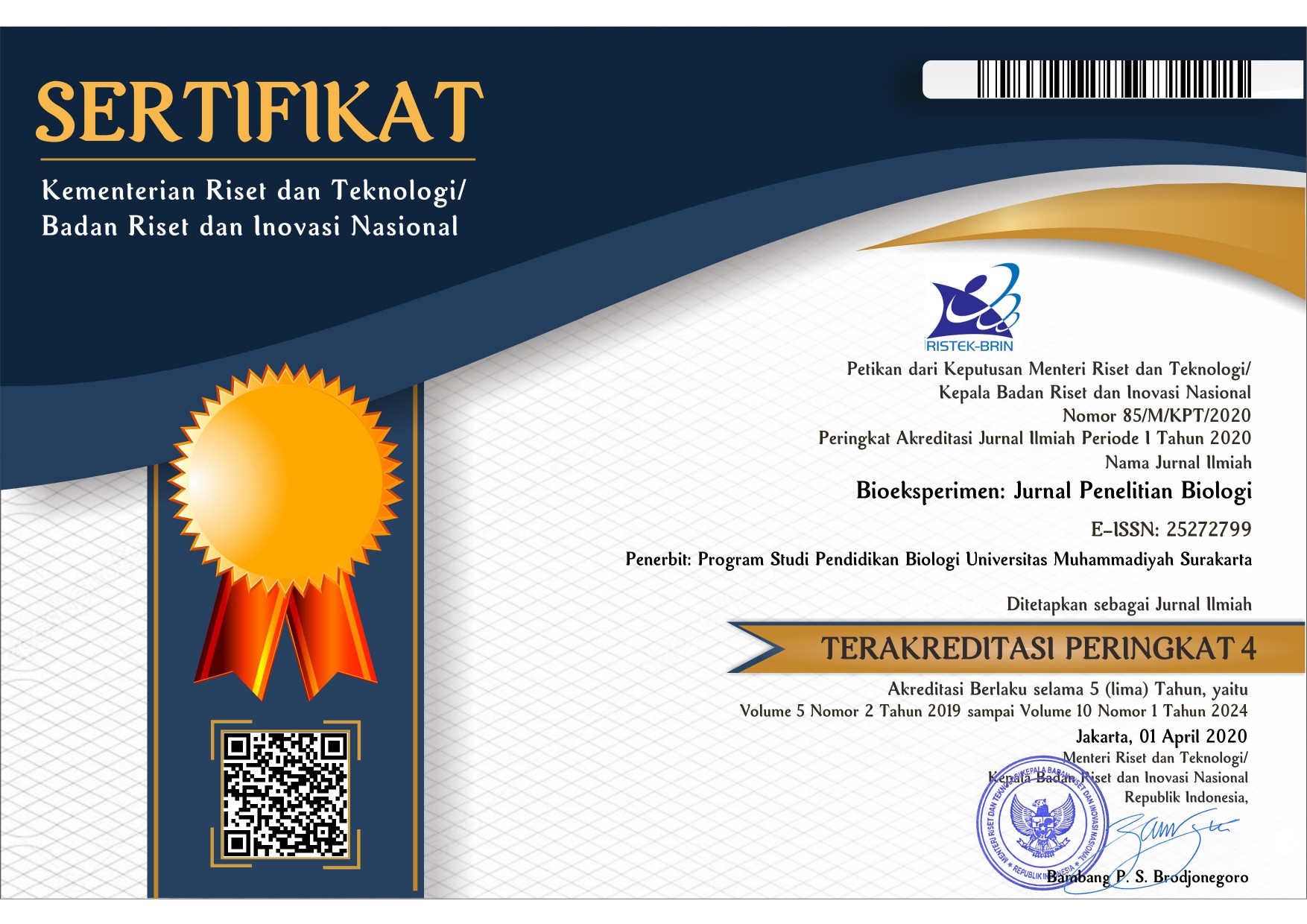Diversity of Crustaceans Family: Portunidae in East Coast Mangrove Forest Reserve Mendahara Resort Tanjung Jabung Timur
Wafiq Nadya(1), Mahya Ihsan(2), Tia Wulandari(3*)(1)
(2) Biology, Faculty of Science and Technology, Jambi University, Muaro Jambi Regency, Jambi, Postal Code 36361
(3) Biology, Faculty of Science and Technology, Jambi University, Muaro Jambi Regency, Jambi, Postal Code 36361
(*) Corresponding Author
Abstract
Crustacea, the largest subphylum in the Phylum Arthropoda, inhabits fresh and seawater. Their bodies are divided into three segments namely cephalo, thorax, and abdominal, or cephalothorax in some crustacean species and they breathe through gills. Crabs are one of the biota that can function as aquatic bioindicators in addition to making a major contribution to nutrient recycling. In the muddy parts of the mangrove forest, the decapod crustacean species Portunidae plays an important ecological function in the environment. This research aims to categorize the crustaceans of the Portunidae family in the East Coast Mangrove Forest Nature Reserve and calculate their dominance, uniformity, and diversity indices. The diversity, uniformity, and dominance index of the Crustacean Family Portunidae in the East Coast Mangrove Forest Reserve area was calculated in this quantitative descriptive research. Purposive sampling is a sampling approach used in survey methods used for sample collection. The results showed that the two different types of crustaceans collected for this study were Thalamita crenata (4125 individuals) and Scylla olivacea (a total 19 individuals). This research shows that in the East Coast Mangrove Forest Reserve area, Thalamita crenata is the most commonly found crustacean species in the Portunidae family. The overall dominance index is in the medium group, while the overall diversity and uniformity index is in the low group. The results of Principal Component Analysis (PCA) show that the environmental factor with the closest relationship and positive correlation between species diversity and uniformity and environmental parameters is salinity.
Keywords
Full Text:
PDFReferences
Abidin, N., Prafiadi, S., & Yunita, M. 2022. Keanekaragaman Spesies Kepiting Bakau (Scylla Sp) di Kawasan Hutan Mangrove Sungai Muturi, Teluk Bintuni. Jurnal Genesis Indonesia, 1(02), 55-65.
Dewi, Y.K., Sudarmadji & Purnomo, H. 2017. Hubungan Keanekaragaman Portunidae dengan Kerapatan Hutan Mangrove Pantai Popongan di Taman Nasional Baluran, Jawa Timur Indonesia. Jurnal Ilmu Dasar. Vol.18(1).
Hasanah, A. N., Rukminasari, N., & Sitepu, F. G. 2014. Perbandingan kelimpahan dan struktur komunitas zooplankton di Pulau Kodingareng dan Lanyukang, Kota Makassar. Torani Journal of Fisheries and Marine Science.
Hernawati, R.T., Nuryanto, A & Indarmawan. 2013. Kajian Tentang Kekayaan Dan Hubungan Kekerabatan Crustacea (Decapoda) Di Sungai Cijalu Kecamatan Majenang kabupaten Cilacap. Jurnal Pembangunan Pedesaan. Vol.13(1).
Hutabarat, S., & Evans, S. M. 2008. Pengantar Oseanografi. UI Press : Jakarta.
Irawan, B., & Soegianto, A. (2006). Kekayaan jenis portunidae di sisi shipping line selat Madura. Berkala Penelitian Hayati, 11(2), 93-96.
Khairunnisa, C., Thamrin, E., & Prayogo, H. (2020). Keanekaragaman Jenis Vegetasi Mangrove Di Desa Dusun Besar Kecamatan Pulau Maya Kabupaten Kayong Utara. Jurnal Hutan Lestari, 8(2).
La Sara., R.O. Aguilar, J.A. Ingles, & L.V. Laureta. 2014. Habitat Characteristics and Relative Abundance Of The Mud Crab Scylla serrata (Forskal, 1775) in Lawele Bay, Southeast Sulawesi, Indonesia. Ege J Fish
Luthfiyana, N., Bija, S., Irawati, H., Awaludin, A., & Ramadani, A. 2021. Karakteristik Thalamitha sp. Hasil Tangkapan Samping Nelayan di Kota Tarakan sebagai Bahan Baku Pangan Bergizi. Jurnal Pengolahan Hasil Perikanan Indonesia. 24(2), 188-199.
Odum, E. P. 1993. Dasar-Dasar Ekologi. Penerjemah: Tjahyono Samingan.
Pasisingi, N. 2012. Produktivitas Sekunder Hewan Bentik Ekosistem Pantai Studi kasus: Produksi Sekunder Nebalia daytoni di Pantai San Diego, California Selatan, USA. Program Studi Pengelolaan Sumber Daya Perairan Sekolah Pasca Sarjana. Jurnal Sumber Daya Perairan .Institut Pertanian Bogor.
Putriningtias, A., Bengen, D. G., & Moosa, M. K. 2014. Struktur dan hubungan kepiting (Brachyura) dengan lingkungan di ekosistem mangrove Kawasan Terusan, Taman Nasional Karimunjawa, Jawa Tengah. Bonorowo Wetlands, 4(2), 82-93.
Ritohardoyo, S & Ardi, G.B. 2014. Arahan Kebijakan Pengelolaan Hutan Mangrove : Kasus Pesisir Kecamatan Teluk Pakedai, Kabupaten Kuburaya, Provinsi Kalimantan Barat. Jurnal Geografi. Vol.11(1).
Serosero, R. 2011. Karakteristik habitat kepiting bakau (Scylla spp) di perairan pantai Desa Todowongi Kecamatan Jailolo Selatan Kabupaten Halmahera Barat. Agrikan: Jurnal Ilmiah Agribisnis Dan Perikanan.Vol.4(1).
Tiurlan E, Djunaedi A, Supriyantini E. 2019. Aspek Reproduksi Kepiting Bakau (Scylla sp.) di Perairan Kendal, Jawa Tengah. Journal of Tropical Marine Science. 2(1): 29-36.
Waisaley, R.S., Kaligus, E.T., Ompi, M., Kumampung, D.R.H., Sinjai, C.A dan Rangan, J.K. 2019. Inventarisasi Jenis Dekapoda di Perairan Pantai Kelurahan Tongkaina, Kota Manado. Jurnal Pesisir dan Laut Tropis. Vol.7(2).
Article Metrics
Abstract view(s): 552 time(s)PDF: 373 time(s)
Refbacks
- There are currently no refbacks.








